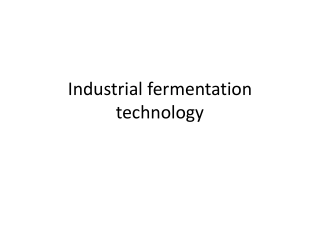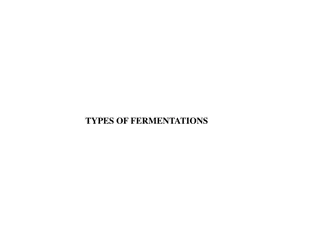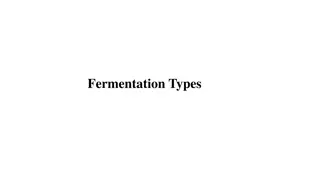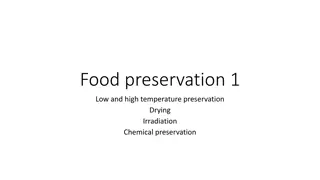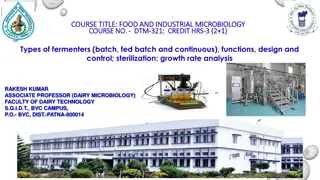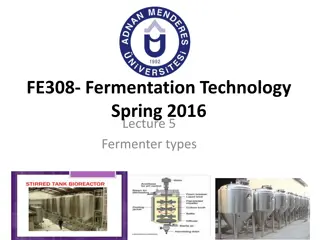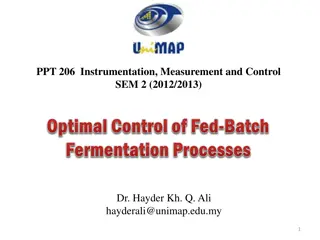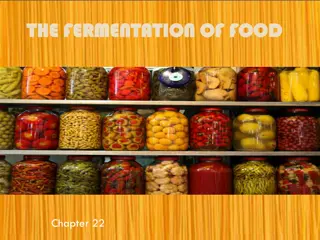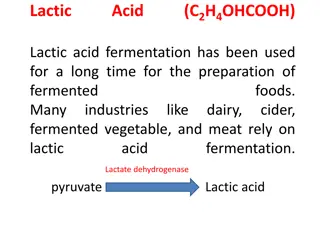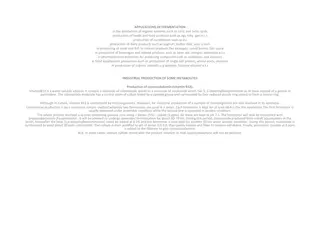Understanding Fermentation Economics: Key Market Considerations
Studying the fermentation economy involves assessing market potential, competition, cost recovery, and distribution strategies. Market demand, competition, production costs, and potential profits are crucial factors to consider for successful commercial fermentation processes. Foreign sales can offer additional market opportunities, but pricing and market acceptance are key considerations. The economic viability of fermentation products depends on their production and distribution costs in a competitive market.
Download Presentation

Please find below an Image/Link to download the presentation.
The content on the website is provided AS IS for your information and personal use only. It may not be sold, licensed, or shared on other websites without obtaining consent from the author. Download presentation by click this link. If you encounter any issues during the download, it is possible that the publisher has removed the file from their server.
E N D
Presentation Transcript
Fermentation Economics The following points are to be considered in studying the fermentation economy : 1. Market Potential : - The requirement for the commercially successful fermentation process is the ability to produce high yield of fermentation product so that the product must be sold so as to recover costs along with an acceptable profit.
- In order to sell the product, there must be a demand or market for the product. - Two Possibilities : A Market for the product may be already exist, because same or similar product have been sold by others. Or Market to be established for a newly discovered fermentation product.
- If market is already exist, then there will be competition for the production and sale of the product. - Fermentation industry newly entering in market must be able to produce the product cheaply enough so that it can be sold at or at slightly less than the going price. - In short the fermentation process and product must be able to compete on an economically sound basis with similar product already in the market.
- Generally fermentation product never sold directly to the public. It may be sold directly to another industry , that chemically transforms the fermentation product before sale to the public. - This do not encounter the additional cost of advertising, packaging and distribution to retail outlets which market the products directly to the public.
- Additional considerations apply to market potential include : the price charged for a fermentation product can be no greater than that which the market will bear. - Product that has no competition in open market is not commercially feasible if the price is too great for public acceptance.
- Foreign sales also present additional market potential for fermentation products but must be determined first whether a market is actually exist for the product or not. 2. Fermentation and Product Recovery Costs : The economic position of a fermentation product is closely associated with cost of its production and distribution.
Following sources of cost can be considered : Medium Constituents : - Competitive position and potential profits from fermentation product are closely tied to the costs of the various components of the production medium. - A single high cost medium component for the production medium can dictate the selling price for the product, so low- cost substitute should be find for replacement of such component.
- Some media require pretreatment to make them acceptable for microbial growth or product accumulation will also add in cost of medium. - The adjustment of pH requires acid or alkali will also contribute little cost to the expense of a medium. - A medium that has a tendency to foam during aeration and agitation can provide additional cost because of lower aeration potential. - A medium that makes fermentation product recovery difficult also adds overall fermentation costs.
Labor Cost : - Labor cost apply to both technical and nontechnical trained personnel. - All labor must be considered, includes labor associated with handling of cultures, inoculums, production, product recovery and purification, maintenance of product sterility, packaging, steam production, equipment maintenance and cleaning, administration and so forth.
- Labor cost may very from fermentation to fermentation, and they may be greater for fermentations requiring prolonged incubation period. Fermentation Incubation Period : - Short incubation period fermentations usually are less costly and it allows a greater turnover of fermentation equipment.
- Fermentations requiring long incubation periods provide additional requirements and costs of labor and present greater potential for contamination. Contamination and Sterilization : - Contamination at more than a minimal level always presents additional costs, since most fermentations do not survive serious contamination and medium must be discarded.
- Moderate contamination seriously affect the yield. - Fermentations in which foaming is a problem, incubation period is long in which fermentation M.O competes poorly with contaminants for nutrients and the product is easily degraded or chemically changed by contaminating organisms. - Some fermentations are also more sensitive to phage.
- Fermentations employing M.O genetically unstable may encounter costs similar to those for contaminated fermentations. Yields and Product Recovery : - The ability of a fermentation to produce high yields and to allow good product recovery is a prime consideration in fermentation economics. - Yields and product recovery must be considered to gather.
Product Purity : - Fermentation products are marketed at various levels of purity. - The purity level required for marketing a fermentation product has a profound effect on the cost associated with that product. - Complicated purification process may leads to considerable loss of fermentation product in each steps of purification process. - A high yield is of little value if the product can not be properly recovered for sale.
Overhead Expenses : - This expenses include rent, taxes, insurance, light, heat, accounting and other office expenses, depreciation and so forth. - This expenses must be considered in the total cost of a fermentation product, but they are not tied to or do not fluctuate to any extent with a particular fermentation.
Waste Disposal : - Disposal of fermentation wastes into streams, rivers or other bodies of water is no longer permissible. - Certain fermentation utilizing pathogens as the fermentation organism , where waste also require additional expense of sterilization before discarding.
- Fermentation waste include waste from the actual fermentation waste from recovery processes, as well as cleaning and cooling waters. - Recovery of economically valuable by-product from a fermentation improves the overall cost and profit picture of fermentation.
Research Costs : - The cost picture of fermentation process also include research that discovered and developed the process as well as the research required for the maintenance of a competitive commercial position for the process. Capital Expenditure : - A newly developed fermentation may require an outlay of capital before commercial production can be undertaken. - Capital expenditure is associated with fermentation equipment and facilities.
Patent Position : - A sound patent position for a fermentation process and product markedly influences the profit picture. - A sound patent position allows that price charged for a fermentation product be as high as the market will bear and that extensive commercial competition will not be encountered. - A good patent position provides greater potential for the recovery of costs and obtaining of an acceptable profit.


